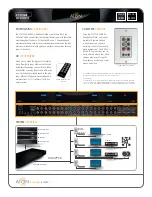
12
Steelhead Appliance Installation and Configuration Guide
Overview of the Steelhead EX
Granite Branch Storage
Granite Branch Storage
Granite is a dual-ended system that enables complete consolidation of storage at the data center, including
private clouds, by providing LAN performance for block-level access. This eliminates the need for
dedicated storage, including management and related backup resources, at the branch office.
Note:
Granite functionality in Steelhead EX requires RiOS 7.0.2.
Granite does the following:
Provides LAN performance for block-level access at the branch office while consolidating storage at
the data center.
Improves performance for custom applications by eliminating the need for custom protocol
optimization.
Extends data-center class thin-provisioned storage to the branch office.
Allows extension of data-center deployed iSCSI SAN to all branch locations.
Eliminates need for storage management and backup resources at the branch office.
Provides “infinite storage” for branch services including virtualized branch services.
Simplifies disaster recovery strategy.
In brief, by consolidating all storage at the data center and creating “diskless branches,” Granite eliminates
data sprawl, costly data replication, and the risk of data loss at the branch office.
For more information about Granite, see the Granite documentation including the
Granite Core Installation
and Configuration Guide
.
How Granite Works
Granite enables edge server systems efficient access to storage arrays over the WAN. Granite is a dual-
ended system with Granite Core at the data center and a Granite-enabled Steelhead EX appliance at the
edge.
The edge server connects to the Granite-enabled Steelhead EX appliance, which implements handlers for
the iSCSI protocol. The Granite-enabled Steelhead EX appliance also connects to the
blockstore
, a persistent
local cache of storage blocks.
When the edge server requests blocks, those blocks are served locally from the blockstore. If they are not
present, they are requested from the data center LUN (logical unit number). Similarly, newly written blocks
are spooled to the local cache, acknowledged to the edge server, and then asynchronously propagated to
the data center. Because each Granite-enabled Steelhead EX appliance implementation is linked to a
dedicated LUN at the data center, the blockstore is authoritative for both reads and writes, and can tolerate
WAN outages without worrying about cache coherency.
Blocks are communicated between Granite-enabled Steelhead EX appliances and Granite Core and the data
center LUN via an internal protocol. (Optionally, this traffic can be further optimized by Steelheads for
improved performance.)
Granite initially populates the blockstore in several ways:
















































